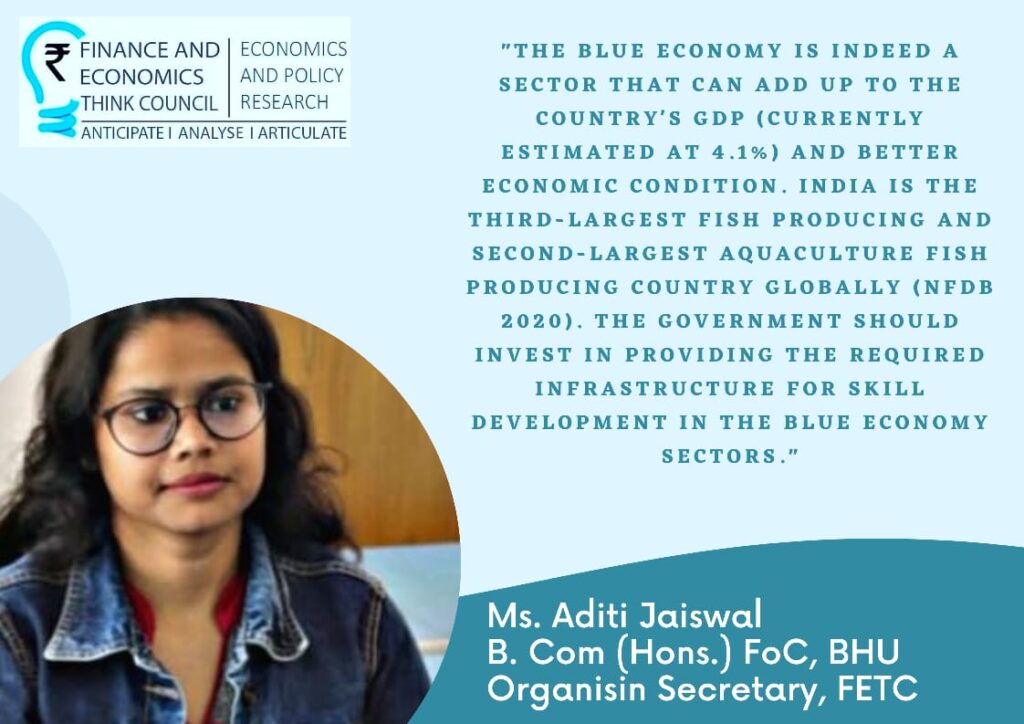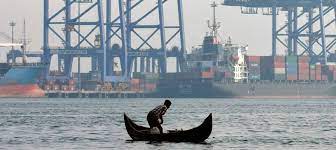
Ocean that covers 70% of the globe remains a vital part of our life. More than 80% of the ocean is still unexplored. The ocean surrounds India on its three sides, and around 30% of its population living in the coastal areas, having a coastal line of approximately 7,517km. It is home to nine coastal states and 1,382 islands.
The ocean is a prominent factor affecting the economy and lives of many people in the country. The fisheries, aquaculture, tourism, blue trade, minerals (seabed extractive activities), food, energy, marine biotechnology and bioprospecting etc., are major economic activities relating to the Blue Economy. Additionally, the seabed mineral extraction activities have made India self-reliant in minerals such as Copper, lead, zinc, limestone, mica, coal etc.
The Geological Survey of India (GSI) emphasizes offshore survey and exploration by Systematic Geological Mapping of 2.159 sq. Km of Indian Exclusive Economic Zone (EEZ), including 0.158 sq. km of Territorial Waters of India, since 1985.
What is Blue Economy?
According to the World Bank, the blue economy is the “sustainable use of ocean resources for economic growth, improved livelihoods, and jobs while preserving the health of the ocean ecosystem.”
The Blue Economy is a growing concept which promotes better stewardship of our ocean or ‘Blue’ resources while reducing the environmental risks.
Reasons to invest in the Blue Economy
• The worldwide ocean economy is valued at around US$1.5 trillion per year.
• 80% of the global trade, by volume, is carried by sea.
• 350 million jobs worldwide are linked to fisheries.
• By 2025, it is estimated that 34% of crude oil production will come from offshore fields.
• Aquaculture is the fastest-growing food sector and provides about 50% of fish for human consumption.
Employment Generation in India by the Blue Economy
Among various activities, the fisheries sector solely provides livelihood to about 16 million fish farmers at the primary stage and almost twice that number along the value chain. The government investment in this sector will have immense potential to double the fish farmers’ incomes.
The shipping sector is also one of the key livelihood providers in the blue economy. India has one of the largest merchant shipping fleets among the developing countries and ranks 17th globally. The number of Indian seafarers employed on Indian and foreign flag vessels crossed over two lakh in 2018, showing an unprecedented increase of 35% over the previous year.
Seaports are also a significant source of employment. Unlike India’s major ports, jobs in smaller ports have increased from 1,933 in 2003 to 19,102 in 2017 (Blue Economic Working Group Report 4).
In Kerala, the total number of jobs created by the sector between 2009 and 2012 turned out to be around 23%. In 2016, the total share of tourism in Tamil Nadu’s employment was more than 22% and 23% in Karnataka’s.
Table: Population dependent on fisheries for livelihood among coastal states in India (according to Blue Economy Working Group Report, Economic Advisory Council to the Prime Minister 2020)
| State | Fishing Villages | Fishing Families | Fisher Farmers Population |
| Andhra Pradesh | 555 (16.2) | 163,427 (18.7) | 605,428 (14.9) |
| Gujarat | 247 (7.2) | 62,231 (7.1) | 336,181 (8.3) |
| Tamil Nadu | 573 (16.7) | 192,697 (22.0) | 802,912 (19.8) |
| Odisha | 813 (23.7) | 114,238 (13.1) | 605,514 (14.9) |
| Karnataka | 144 (4.2) | 30,713 (3.5) | 167,429 (4.1) |
| Kerala | 222 (6.5) | 118,937 (13.6) | 610,165 (15.0) |
| Goa | 39 (1.1) | 2,189 (0.3) | 10,545 (0.3) |
| Maharashtra | 456 (13.3) | 81,492 (9.3) | 386,259 (9.5) |
| West Bengal | 188 (5.5) | 76,981 (8.8) | 380,138 (9.4) |
Note: Figures in bracket show the shares in percentage
This sector has been among the worst-hit due to the Covid-19 crisis. Nonetheless, coastal states are re-strategizing to attract local and domestic tourists, focusing on single or small groups interested in adventure and eco-tourism.It can help the economy to recover from the consequences of Covid-19.
It will eventually promote a renewable and clean way for energy generation reducing waste and encouraging recycling of materials. It can restore & protect the marine ecosystem as well.

Government Plans to boost the Blue Economy.
The Blue Economy is among the top ten core dimensions of growth in ‘The Vision of New India by 2030’ .Niti-Aayog has set up a panel to better coordinate and integrate the GOI’s initiatives in the Blue Economy.
Deep Ocean Mission
It is an initiative taken by the Ministry of Earth Sciences (MoES) and approved by the Cabinet Committee on Economic Affairs (recently) to support India’s Blue Economy.
The mission deals with exploring the deep ocean for resources and develop deep-sea technologies for sustainable use of ocean resources. It is to be implemented at an estimated cost of Rs. 4,077 crore for five years in phases, the first phase’s estimated cost is Rs. 2823.4 crores for three years, i.e., 2021-2024.
The technologies required for the research are planned to be indigenized in collaboration with the private industries. A research vessel will be developed in an Indian shipyard for deep ocean exploration (Marine Biology). It will not only boost employment opportunities but also spur the growth of the Indian Industry.
A Sustainable and Equitable Blue Recovery to the COVID-19 Crisis Report (India-Norway)
The fourth meeting of the Indian-Norway Task Force was held on 9th June 2021, i.e., the World’s Ocean Day. The Task Force was created in 2019. The report focuses on five prominent actions to boost the blue economy.
Besides investment in protecting the marine ecosystem and aquaculture, it also focuses on zero-emission maritime transport, sewage infrastructure for coastal communities and sustainable ocean-based renewable energy.
Recently, India-Norway Integrated Ocean Management & Research has also been established to promote the expansion of ocean industries.
Research commissioned by the standardized panel co-chaired by Norwegian PM for sustainable blue economy shows that every dollar invested in key ocean activities (like blue trade, decarbonizing international shipping, seafood production, scaling up wind power, conserving & restoring mangroves) yields five times in return and often more.
Indian & Norwegian business plans to create job opportunities while investing in green technologies. For example, Norwegian companies Kongsberg Maritime & Wilhelmsen have contracted Cochin Shipyard to build two zero-emission autonomous ferries.
The vessels will replace 2 million km of truck transport, saving 5,000 tons of CO2 emission annually. Port of Oslo and JNPT in Maharashtra are starting a collaboration for sustainable ship recycling.
Two key MoUs have also been signed-
One, Norwegian University NTNU and DG Shipping agreed to establish a maritime knowledge cluster soon. Two, Norwegian company Greenstat & the Indian Oil Corporation set up a Center of Excellence on Hydrogen.
Conclusion
The Blue Economy is indeed a sector that can add up to the country’s GDP (currently estimated at 4.1%) and better economic condition. India is the third-largest fish producing and second-largest aquaculture fish producing country globally (NFDB 2020).
The government should invest in providing the required infrastructure for skill development in the blue economy sectors. This can be done by financially supporting the initiatives and programs that focus on expanding human resource for the sectors of blue economy. The level of awareness of employment opportunities in the blue economy needs to be increased both at the central and state levels.
This can be done by conducting frequent sessions with the target audience at both the school and university levels. The investment done in this sector can be very beneficial. Current economic trends have been degrading ocean resources. The government should boost this sector, keeping a balance between the economy and the environment.
